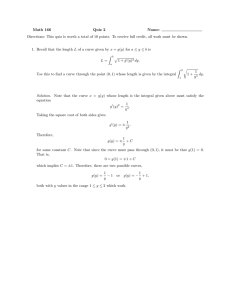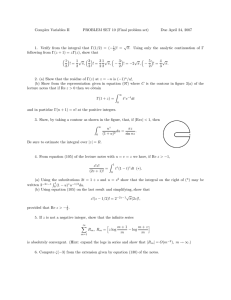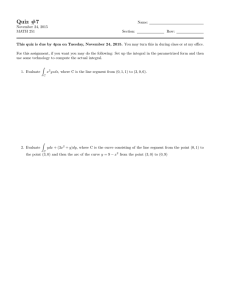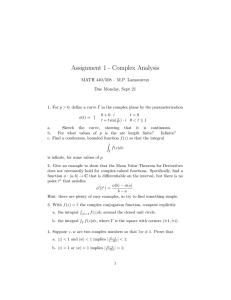Document 13570492
advertisement
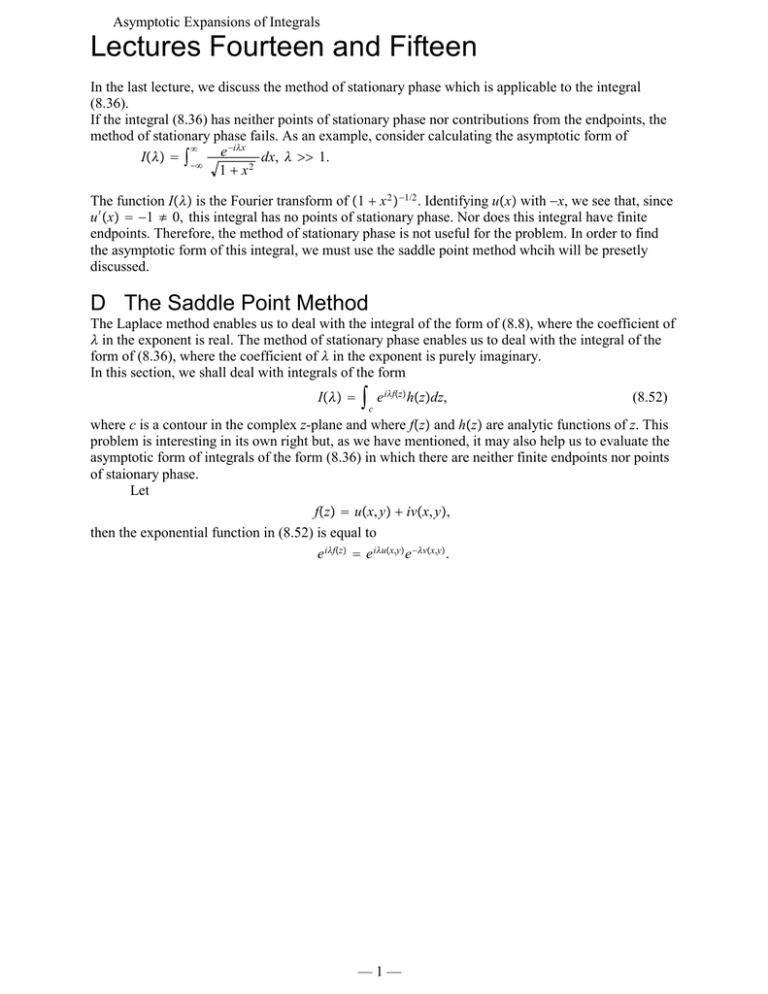
Asymptotic Expansions of Integrals Lectures Fourteen and Fifteen In the last lecture, we discuss the method of stationary phase which is applicable to the integral (8.36). If the integral (8.36) has neither points of stationary phase nor contributions from the endpoints, the method of stationary phase fails. As an example, consider calculating the asymptotic form of K e ?iRx dx, R ;; 1. IΩRæ : X ?K 1 + x2 The function IΩRæ is the Fourier transform of Ω1 + x 2 æ ?1/2 . Identifying uΩxæ with ?x, we see that, since u r Ωxæ : ?1 é 0, this integral has no points of stationary phase. Nor does this integral have finite endpoints. Therefore, the method of stationary phase is not useful for the problem. In order to find the asymptotic form of this integral, we must use the saddle point method whcih will be presetly discussed. D The Saddle Point Method The Laplace method enables us to deal with the integral of the form of (8.8), where the coefficient of R in the exponent is real. The method of stationary phase enables us to deal with the integral of the form of (8.36), where the coefficient of R in the exponent is purely imaginary. In this section, we shall deal with integrals of the form IΩRæ : Xc e iRfΩzæ hΩzædz, (8.52) where c is a contour in the complex z-plane and where fΩzæ and hΩzæ are analytic functions of z. This problem is interesting in its own right but, as we have mentioned, it may also help us to evaluate the asymptotic form of integrals of the form (8.36) in which there are neither finite endpoints nor points of staionary phase. Let fΩzæ : uΩx, yæ + ivΩx, yæ, then the exponential function in (8.52) is equal to e iRfΩzæ : e iRuΩx,yæ e ?RvΩx,yæ . — 1 — Asymptotic Expansions of Integrals We see that the coefficient of R in the exponent above has both a real part and an imaginary part. In section 8B, we have treated the case in which u is zero. And in Section 8C, we have treated the case in which v is zero. We now treat the case with neither u nor v equal to zero. The magnitude of the integrand is sharply peaked around the point z 0 at which v is minimum. But if u r is not equal to zero, the integrand also oscillates rapidly in the neighborhood of z 0 , and the resulting cancellation wipes out entirely the contribution of z 0 . Let us deform, by Cauchy’s integral theorem, the contour c into another contour c r . If u happens to be a constant on the contour c r , then IΩRæ : e iRa X e ?Rv hΩzædz, c where a is the value of u on c r . Thus there is no cancellation due to the rapid changes of the phase factor of the integrand and the dominant contribution to the integral comes from the point z 0 on c r at which v is minimum. The asymptotic form of the integral can be obtained with the use of Laplace’s method. The point z 0 may be an endpoint of c r . In such a case, we may obtain the leading term of the integral by expanding the integrand around the endpoint and carry out the integration over an exponential function. The point z 0 may also be an interior point of c r . We shall argue that, if z 0 is an interior point of c r , all partial derivatives of u and v must vanish at z 0 . We begin by observing that, since v is minimum at z 0 along the curve c r , the variation of v in the tangential direction of c r vanishes at z 0 . Also, since u is constant on c r , the variation of u in the tangential direction of c r is zero. The latter means that, by the Cauchy-Riemann equation, the variation of v in the direction orthogonal to the tangential direction of of c r is zero. Thus both partial derivatives of v vanish at z 0 . By the Cauchy-Riemann equations, so do the two partial derivatives of u at z 0 . Indeed, f r Ωz 0 æ : 0. The point z 0 is known to be a saddle point for the integral (8.52), as we shall explain further below. Since, along the contour c, v is minimum at z 0 and u is stationary, the dominant contribution to the integral over c comes from the saddle point z 0 . The asymptotic form of the integral can be obtained by expanding the integrand around z 0 and carrying out the Gaussian integrals. As we deform the contour, we may encounter singularities of the integrand. The Cauchy integral theorem is then no more applicable and we may not deform the contour beyond the singularity. Thus the singularity may contribute a dominant contribution to the integral. In summary, for the integral of the general form (8.52), the possible points of contribution are the singular points, the endpoints, and the saddle points. There may be more than one saddle points or singular points in the problem. Not all of them contribute to the asymptotic form of the integral. We must decide what contour to deform to and which saddle points or singular points are relevant. We shall show how to do this below. Doing this will require a little understanding of complex analysis. Here we’ll add to our previous discussions on this topic. A curve on which u is a constant is called a level curve of u. A curve on which v is a constant is called a level curve of v. We shall show that, with certain notable exceptions, the level curves of u intersect orthogonally with the level curves of v. Problem for the Reader: Consider in the complex plane the function fΩzæ : z 2 : Ωx + iyæ 2 . Draw the level curves of u as well as those of v for this function. Answer We have uΩx, yæ : x 2 ? y 2 , and vΩx, yæ : 2xy. We draw the level curves of u and the level curves of v :constant in the figure below. —2— u = ­1 = v= 0 y = u = ­1 0 u u 0 Asymptotic Expansions of Integrals u= 1 u= 1 D' C' E F v = ­1 A v= 1 v= 0 B x v= 1 C D E' F' u= 1 u= 1 u = ­1 0 u = ­1 = = 0 u u v = ­1 Figure 8.8. Question for the Reader: Do the level curves of u and those of v intersect orthogonally? Answer Yes, as we can see from Fig. 8.8, the level curves of u generally intersect orthogonally with those of v. But there is one notable exception. There are two level curves of u and two level curves of v intersecting at the origin. The level curves of u and those of v do not intersect orthogonally at the origin. Instead, the two level curves of u intersect orthogonally at the origin. So do the two level curves of v. We note also that the derivative of fΩzæ vanishes at the origin, which is where the aforementioned unsual behavior occurs. As a general rule, if u and v are harmonic conjugates of each other the level curves of u and those of v intersect orthogonally, . To see this, we express the infinitesimal variation of uΩx, yæ as du : u x dx + u y dy. Now on a level curve of u, the value of u does not vary. Therefore we have u x dx + u y dy : 0, where dx and dy are the variations of x and y between two neighboring points on the level curve of u. 3 is perpendicular to the tangent vector of the level curve of u. This says that 4u 3 Similarly, 4v is perpendicular to the tangent vector of the level curve of v. Now 3 6 Ω4væ 3 : u x v x + u y v y : 0, Ω4uæ where the last step is obtained with the use of the Cauchy-Riemann equations (2.9). Therefore, at the point a level curve of u and a level curve of v intersect, the tangent vectors of these two curves are othogonal to each other. But there are exceptions. The points of exception are the points at which the derivative of fΩzæ 3 and 4v 3 vanishes. At each of such points, all of the partial derivatives of u and v vanish. Thus both 4u 3 and 4v 3 are null vectors at such a point and neither possess a direction. While the scalar product of 4u r remain to vanish at a zero of f , it is due to the vanishing of the gradient vectors, and not due to the orthogonality of the gradient vectors. Note also that two level curves of u generally do not intersect. Let a level curve be given by uΩx, yæ : c. And let Ωx 0 , y 0 æ be a point on this curve. Now by the implicit function theorem, the equation above has a unique solution in a neighborhood of Ωx 0 , y 0 æ with the form y : yΩxæ, provided that u y Ωx 0 , y 0 æ é 0. Similarly, it has a unique solution in a neighborhood of Ωx 0 , y 0 æ with the — 3 — Asymptotic Expansions of Integrals form x : xΩyæ, provided that u x Ωx 0 , y 0 æ é 0. Thus, unless both u x and u y vanish, there can only be one level curve passing through the point Ωx 0 , y 0 æ. But at the point z 0 at which f r Ωz 0 æ : 0, both u x and u y vanish, and there is no reason why two level curves of u cannot intersect at z 0 . Indeed, we see in the example above that two level curves of u do intersect at the origin. Also, two level curves of v in this example also intersect at the origin. We have learned in calculus that if the derivative of a function of a real variable x vanishes at x 0 , then it has an extremum at x 0 provided that its second derivative does not vanish. This is quite different for uΩx, yæ and vΩx, yæ, which are functions of two variables. Near the point z 0 at which the derivative of fΩzæ vanishes, we have fΩzæ ? fΩz 0 æ p f rr Ωz 0 æΩz ? z 0 æ 2 /2. Therefore, if f rr Ωz 0 æ é 0, the behavior of fΩzæ near z 0 is the same as the function z 2 near the origin. Problem for the Reader: Let vΩx, yæ : 2xy, the imaginary part of z 2 . What is the behavior of v on the line x : y and the line x : ?y? What does v look like near x : y : 0? Answer The line x : y is a level curve of u. On this line v:2x 2 , and is minimum at the origin. The line x : ?y is also a level curve of u. On this line v : ?2x 2 , and is maximum at the origin. If we consider vΩx, yæ as a function of x and y in a three-dimensional space, it resembles the surface of a saddle near the point x : y : 0, where the line x : y is in the front-back direction of the saddle, and the line x : ?y is in the sidewise direction of the saddle. The function vΩx, yæ is neither absolutely maximum nor absolutely minimum at the origin. Thus the origin is a saddle point of v. Similarly, the origin is a saddle point of u : x 2 ? y 2 . If u and v are the real part and the imaginary part of an analytic function the derivative of which vanishes at z 0 , then z 0 is a saddle point of u and that of v. By definition, the value of a function vΩx, yæ does not vary on any of its level curves. Thus it varies most rapidly in the direction orthogonal to its level curve. Since the level curves of u intersect those of v orthogonally, v varies most rapidly on a level curve of u, and u varies most rapidly on a level curve of v. As a consequence, the function e ?Rv varies most rapidly on a level curve of u. Now we have seen that there are two level curves of u passing through the point z 0 . We have also seen that the function vΩx, yæ is minimum on one of these curves, and maximum on the other curve. Thus the function e ?RvΩzæ decreases most rapidly as one leaves z 0 on the former curve. This curve is called the path of steepest descent. Similarly, e ?RvΩzæ increases most rapidly as one leaves z 0 on the latter curve, which is called the path of steepest ascent. Consider now the integral in the general form of (8.52). If c is a level curve of uΩx, yæ, the phase of the exponential function of (8.52) is a constant and can be taken outside of the integral. Also, the magnitude e ?RvΩx,yæ varies most rapidly on c. Thus the integral is of the form of (8.8), and the dominant contributions come from the point at which v is minimum. It is therefore a good idea to deform the contour of the integral of (8.52) into a level curve of u, for then the asymptotic form of the integral can be obtained with the Laplace method. Take the example of (8.47), in which fΩzæ : z 2 . We cannot easily go from ?1 to 1 on a curve of constant u. Let us therefore take the path ACDEFB in the figure. Along the path AC, the phase uΩx, yæ is a constant and vΩx, yæ is minimum at the endpoint A. Thus the dominant contribution to the integral along AC is given by a small neighborhood of width 1/R near the endpoint A, and can be calculated by the Laplace method. The result is the same as we have obtained by using the formula (8.39) and keeping only the contribution from the endpoint A. The contour CD is not a level curve of u. Instead, it is a level curve of v, on which v : 1. The integrand on CD is as small as e ?R , hence the integral over CD will be neglected. Next we consider the contour DE. This contour is a path of steepest descent with the saddle point at the origin. Thus we may again use the Laplace method to evaluate the contribution of the origin, and the answer is the same as that calculated with the use of (8.45). The contribution of the contour EF, which is not a level curve of u, will be neglected as the integrand is exponentially small on this contour. The dominant contribution of the contour FB, which is a level curve of u, comes from the point B. Applying the Laplace method gives us the same —4— u = ­1 = v= 0 y = u = ­1 0 u u 0 Asymptotic Expansions of Integrals result obtained with the use of (8.39). Thus, by deforming the contour of integration, we succeed in verifying (8.48) with the application of the Laplace method. u= 1 u= 1 D' C' E F v = ­1 A v= 1 v= 0 B x v= 1 C D E' F' u= 1 u= 1 u = ­1 0 u = ­1 = = 0 u u v = ­1 Figure 8.8. We note that it will not be fruitful to deform the contour from the real axis to the curve AC’D’E’F’B. For if we do this, we will find that on the curve AC’, v is minimum not at A but at C’. Thus the dominant contributions to the integral over AC’ come from the point C’, where the integrand is of the order of e R . This large term is cancelled by an equally large term with the opposite sign coming from the integral over C’D’. Also, while the contour D’E’ passes through the saddle point z : 0, this contour is one of the steepest ascent and the contributions of this contour come not from the saddle point z : 0 but from the endpoints D’ and E’. Indeed, the integral over each of the segments of the curve AC’D’E’F’B has a very large leading term. These terms cancel one another and it is extremely difficult to determine what remains after such extensive cancellations. Therefore, as we start from an endpoint of the contour and try to deform the contour to a level curve of u, be sure to go in the direction v increases, not the other way around. It is possible to deform the contour into a sum of curves all of which are level curves of u. Instead of taking the contour ACDEFB to go from A to B, we may go from A to C on the level curve of u as before, but instead of making a turn at C, we follow this level curve all the way to infinity. We then change over at infinity to the line x : y, and go from one infinite end of this straightline to another infinite end of this straightline. Then we change over at infinity to the level curve on which F and B lie to arrive at B. In this way u is a constant on each of the segments of the contours. Applying the Laplace method to each of the contours, we may obtain not only the leading term but also the next leading terms. To do this, we merely have to keep more terms in the expansions of the integrand around the points of contribution and carry out the integration. — 5 —
